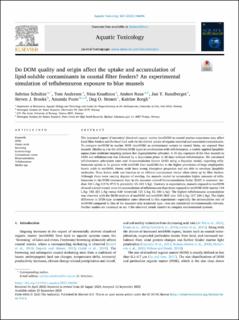Do DOM quality and origin affect the uptake and accumulation of lipid-soluble contaminants in coastal filter feeders? An experimental simulation of teflubenzuron exposure to blue mussels
Schultze, Sabrina; Andersen, Tom; Knudtzon, Nina Cathrine; Ruus, Anders; Rundberget, Jan Thomas; Brooks, Steven; Poste, Amanda Elizabeth; Hessen, Dag Olav; Borgå, Katrine
Peer reviewed, Journal article
Published version
Permanent lenke
https://hdl.handle.net/11250/3102514Utgivelsesdato
2023Metadata
Vis full innførselSamlinger
- Publikasjoner fra Cristin - NIVA [2149]
- Scientific publications [1172]
Sammendrag
The increased export of terrestrial dissolved organic matter (terrDOM) to coastal marine ecosystems may affect local filter feeders and the local food web via the altered uptake of organic material and associated contaminants. To compare terrDOM to marine DOM (marDOM) as contaminant vectors to coastal biota, we exposed blue mussels (Mytilus sp.) to the different DOM types in combination with teflubenzuron, a widely applied lipophilic aquaculture medicine targeting salmon lice (Lepeophtheirus salmonis). A 16-day exposure of the blue mussels to DOM and teflubenzuron was followed by a depuration phase of 20 days without teflubenzuron. We calculated teflubenzuron adsorption rates and bioaccumulation factors (BAF) using a Bayesian model, expecting teflubenzuron uptake to be greater with terrDOM than marDOM due to the higher prevalence of large amphipathic humic acids in terrDOM. Humic acids have strong absorption properties and are able to envelope lipophilic molecules. Thus, humic acids can function as an efficient contaminant vector when taken up by filter feeders. Although there were varying degrees of overlap, the mussels tended to accumulate higher amounts of teflubenzuron in the DOM treatments than in the seawater control (bioaccumulation factor [BAF] in seawater: median 106 L/kg; 2.5 %–97.5 % percentile: 69–160 L/kg). Contrary to expectations, mussels exposed to marDOM showed a trend toward more bioaccumulation of teflubenzuron than those exposed to terrDOM (BAF marine 144 L/kg; 102–221 L/kg versus BAF terrestrial: 121 L/kg; 82–186 L/kg). The highest teflubenzuron accumulation was observed with the 50:50 mixture of marDOM and terrDOM (BAF mix: 165 L/kg; 117–244 L/kg). The slight difference in DOM-type accumulation rates observed in this experiment—especially the accumulation rate of terrDOM compared to that of the seawater-only treatment type—was not considered environmentally relevant. Further studies are necessary to see if the observed trends transfer to complex environmental systems.

